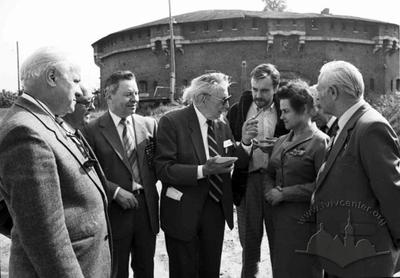Vul. Hrabovskoho, 11 – former Great Maximillian Tower No. 2
ID:
39
The Great Maximillian Tower No. 2 is a double-level casemate artillery tower with a cellar and a flat terrace, built of unplastered red brick. Constructed as a regular heptadecagon with a circular internal courtyard by an unknown architect on Kalicha Hill. The tower's chief function was control of the city in case of an uprising, and defense of the Citadel's eastern wing. Beginning in early July 1941, the Nazi troops dislocated a concentration camp for prisoners of war in the Citadel, the so-called Stalag 328. According to testimony from Soviet prisoners of war, Tower No. 2 held the interrogation room and the death row cell. Beginning in 1980 the tower and the territory was used as storehouses by the Electron company. Currently (2009), the tower is being used as a hotel "Citadel Inn".
Architecture
The tower was planned as a regular 17-gon with a circular inner courtyard. A dry ditch and an earth bulwark with a supporting wall presents the external defensive system, which makes access to the fort difficult and shields the first, living level of the building from enemy fire. The bottom of the ditch is paved with sandstone plates. A drawbridge was built over the ditch, which, when drawn up, covered the entrance gate and the battlement above it. The bridge could be drawn up by means of a chain mechanism located in the rooms of the first and second floors. The tower consists of two levels, as well as a cellar and an attic. Construction of the levels was planned as a system of corridors with enfilades connecting some of the first level rooms. The windows of the circular corridors on both levels overlook the internal courtyard. The staircase, which is semicircular from above, extends into the internal courtyard. The balanced stairs between the levels consist of a single flight. The façade that holds the portal of the main entrance has a niche, concluding with an arc. The vestibule by the entrance section, as well as the partitions between the cellar, the first and second levels exhibit quadrangular apertures that form a vertical shaft for passing cannons and ammunition. The terrace of the tower formerly held a mechanism for this purpose. On the level of the terrace, the aperture of the vertical shaft is framed by whitestone with grooves to allow installation of a metallic double-pitch rooflet.
Related Places
Personalities
The Architect is unknown. Construction was approved by the Central Committee for Defense Construction in Vienna. According to an 1853 map of the Lviv Citadel retrieved from the Military Archive in Vienna, chief engineer of the project was I. Wondraszka. (Kriegsarchiv Wien)
Sources
- Archive of the "Ukrzakhidproektrestavratsiya" Institute 88-9-НИ, ІІІ-01-01.
- T. Piniazhko. Lvivska Tsytadel. Lviv, 2005.
- Kriegsarchive, Wien Inland CVI Lemberger Citadelle Nr. 2.
- Fort 31 św. Benedykt
- Władysław Marian Wolff. Strzępy wspomnień z obrony Lwowa
- Stanisław Kobielski. Cytadela we Lwowie. Zarys historii i opis wyglądu oparty na własnych wspomnieniach
Material compiled by Taras Piniazhko
Edited by Mykhailo Slobodianiuk
Media Archive Materials
Related Pictures















